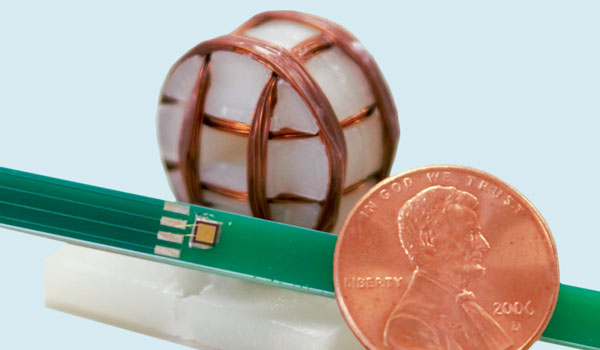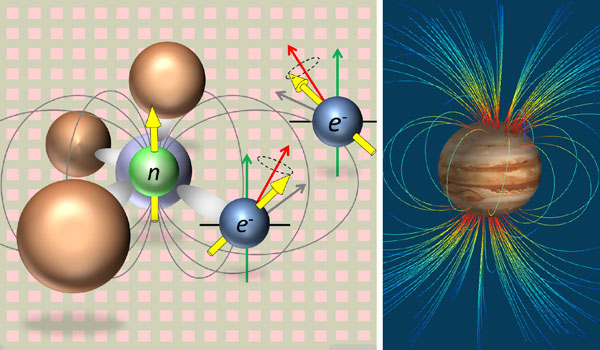Above:
The silicon carbide magnetometer (SiCMag) is capable of making vector measurements ideal for mapping the magnetic field of planetary bodies.
SiC Magnetometer
Silicon Carbide Magnetometer
Hannes Kraus – Corey Cochrane – NASA Glenn
The Silicon Carbide Magnetometer (SiCMag) is a next-generation solid-state magnetometer that leverages quantum centers—i.e. atomic scale defects—intrinsic to a SiC semiconductor to sense the magnetic fields of planetary bodies. These mid-gap quantum centers give rise to a magnetoresistive response that is facilitated by electron-nuclear hyperfine mixing of the electron spin pairs involved in spin-dependent recombination (SDR) at near-zero magnetic fields. The zero-field SDR phenomenon therefore allows for the electrical readout of a spin-dependent current that encodes the ambient magnetic field in which the sensor is immersed. It is the first ever magnetometer of its kind.
Magnetometers are essential for scientific exploration of planetary bodies, as they can remotely probe the interiors of planets to gain insight on internal composition, dynamics and even the evolution of the body being investigated. These instruments are therefore ubiquitous on almost all missions in space.
If shown to be as sensitive as optically pumped atomic gas and fluxgate magnetometers, SiCMag could be the future instrument of choice since it is significantly less complex and smaller than previous designs and thus is well suited for implementation on nano- or pico-satellites where swarms or a constellations of very small research spacecraft. could be deployed. SiCMag, due to the wide bandgap (3.3 electron volts) of the material, has the potential to operate in the high-radiation belts of Jupiter or even on the hot Venusian surface, which can exceed 460 degrees C, and give science returns otherwise not possible in those environments.
This robustness provides SiCMag with the ability to simultaneously be used as a total dose radiation monitor as well as a temperature sensor. Additionally, the magnetic isotopes of the host and dopant atoms that are responsible for the nuclear hyperfine interaction act as tiny bar magnets in the vicinity of the quantum center site. These magnetic signatures allow for the magnetometer to self-calibrate and do not change with time or temperature. Furthermore, because of SiCMag’s simplicity and small scale, dozens can be placed around a large-scale spacecraft that allows for inter-sensor calibration, redundancy, gradiometric measurements, and cancellation of the contaminant spacecraft field, which could potentially remove the need for a magnetometer boom.
In essence, the entire instrument is composed of a SiC diode enclosed by three very small sets of orthogonal Helmholtz coils, a high-gain current amplifier, a few analog-to-digital and digital-to-analog converters, and a Field-Programmable Gate Array (FPGA). The coil system is used to modulate the ambient magnetic field in each dimension with a different frequency that is sensed by the diode. The current from the diode is amplified, conditioned and then sampled prior to being digitally demodulated in the FPGA for extraction of the three frequency-division multiplexed vectorized current components. A controller within the FPGA tracks the zero-crossing of each component, which is proportional to the ambient magnetic field in each axis and therefore used to null the field at the sensor using the three-axis coil system. Note that no optical or high frequency radio components are required for the instrument.
SiCMag inherits many of its important features from the 4H SiC crystalline sensor that lies at the heart of the instrument. Silicon Carbide is extremely robust and has the ability to operate in harsh planetary magnetic fields, sensing with quantum centers in SiC, which are fundamental physical constants in nature. Currently, our “off-the-shelf” sensor is characterized with sensitivity on the order of 100 nT Hz-1/2, as it was not designed in any way for magnetometry. We are currently working with NASA’s Glenn Research Center to design and fabricate a variety of custom sensors, which we foresee will operate with a sensitivity on the order of 1 nT Hz-1/2 with the aid of quantum center engineering via controlled proton irradiation. SiCMag is not currently set to fly on a mission due to the technology’s infancy, but there has been a lot of interest in flying the instrument on a CubeSat, Lunar rover, or even a drone here on Earth.
The SiC sensor and the 3-axis, 3D printed Helmholtz coil system used to modulate and null the external magnetic field.
+ Larger image
Low-field defect spectrum of 4H SiC diode, implanted with nitrogen, illustrating the resonant spin-dependent recombination (electrically detected magnetic resonance at 250MHz) and
zero-field spin-dependent recombination (hyperfine mixing). The arrows illustrate the electron-nuclear hyperfine interactions that allow for self-calibration and facilitate the mixing of the quantum center energy states.
+ Larger image
Left: Conceptual illustration of a quantum center with representative sensor mask (250 microns x 250 microns) in background.
Right: Representative example (Jupiter VIP4 model) of the potential magnetic field mapping capability from the measurements made by SiCMag.
+ Larger image


